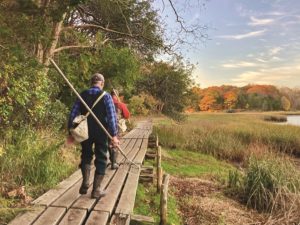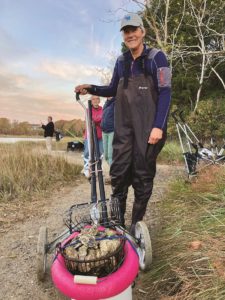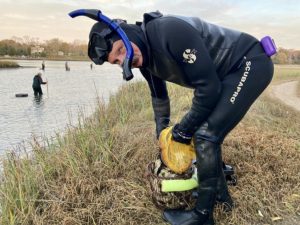EASTHAM — First light breaks on a balmy November Sunday. Dried leaves rustle in the steady breeze, but otherwise the waking world is hushed, silent even of birdsong. I have Route 6 to myself, but pickups pack the town landing at Salt Pond nose to tail along the steep driveway.
By the glow of headlights and dashboards, friends and neighbors greet each other. Game-day gear is unloaded, boots and gloves are donned, buckets, baskets, and shellfish rakes are piled onto cast-off golf pull carts, and the march to Salt Pond River begins.
It’s Oyster Sunday, when Eastham permit holders can harvest their weekly 10 quarts from the tidal river that connects Salt Pond to Salt Pond Bay and the Nauset Marsh estuary.

Salt Pond Sundays are part of a town-run program offered April through November and enjoyed by locals and visitors during the two- to three-hour period straddling low tide. There are four this month (by the time you read this there will be just two more, on Nov. 20 and 27).
In spring and summer, quahogs are collected. That’s what most permit holders — there were 2,139 of them this season — focus on. But come fall, for a short time the prize is oysters, and 10 quarts are about 75 of the briny bivalves.
By dint of the tides, today’s harvesting window opens promptly at 6 a.m.
“Let it go on record that some people are unhappy that the select board couldn’t do something about the time of the tide,” says Eastham resident Bob Cook. He’s walking with Aimée Eckman, a select board member, and Aimée’s partner, Joanna Stevens.

“In years past, the town would buy seed, and we’d grow them out here on Salt Pond,” Eckman says. Things changed during the pandemic, when restaurants across the country shut down, leaving local aquaculturists with oysters they couldn’t sell.
Standing at the mouth of Salt Pond River, Harbormaster Scott Richards checks permits and records the day’s take. He elaborates on Eastham’s oyster efforts. “We started purchasing from local growers to help them out,” he says. But, he says, the program has continued because it also helps his small workforce at the natural resources dept.
Growing out the oysters was labor intensive. Now the dept. buys them at size, Richards says: “They’re all three inches and there’s no measuring required. You just fill your bucket and go.”
On the other side of the channel, Nicole Paine — now in her seventh year as Eastham’s shellfish constable — is also checking permits while giving pointers to first-timers and an impromptu class on aquaculture to curious onlookers.
According to Paine, about 13,300 oysters grown by farmers working in Nauset Marsh and Town Cove have been broadcast in Salt Pond River so far this year. Another distribution of 9,000 is planned before Nov. 20. The town determined a fair price for the purchased oysters that was “as close to wholesale as we could get,” Paine said — around 60 cents apiece.
With oysters enough to go around, there’s not much competition at Oyster Sunday. Several liken it to an Easter egg hunt for adults. Still, there’s a feeling of anticipation in the air as 6 a.m. approaches. About 50 people line the riverbanks, waiting expectantly for Paine and Richards to signal the official start of the harvest.
Past Oyster Sundays have drawn upwards of 200 people, and some recall a shotgun or airhorn start. Today a modest wave and nod from Paine and a joking “git ’er done” from Richards are perfectly synced with the sunrise above Nauset Spit.
Some 2,000 of the oysters broadcast this year were from an aquaculture grant in Nauset Marsh estuary that was abandoned by a grower who could not keep working it due to illness. In late October, with help from Laura Ludwig of the Center for Coastal Studies, town staff and volunteers spent two days clearing the site. Paine says they cleaned up approximately 250 bags, 75 cages, 500 feet of rope, chain, and anchors from the site and were able to cycle around 75 percent of the gear back into the aquaculture community.
Cleaning up a disused site like this is not the town’s responsibility, but this was a unique situation, Paine says. And now, the grant — a license to work this parcel — can be offered to someone on the 14-person wait list for grants in Nauset Marsh and Boat Meadow.

For many, Oyster Sunday is an annual tradition. For others, today is a first foray. Novices stand out by virtue of their pristine shellfish rakes with shiny tines and unsullied wooden handles. The more experienced tote rusty wire baskets with pieces of pool noodle duct-taped to the rims for buoyancy. One participant arrives in shorts and T-shirt, equipped with only thin-soled shore shoes — “the better to feel for the oysters on the sandy bottom.” D.J. Scholl, a regular from Eastham, literally dives in, suited head-to-toe in snorkeling gear.
As harvesting gets underway, the scene is surprisingly quiet. With heads down and eyes trained on the muddy river bottom, participants are intent on the take. They sift through seaweed, empty shells, and the occasional crab, picking out oysters and steadily dropping them into the floating baskets tethered to their waists. Those who arrive earliest and get straight to it fill their baskets within a half hour. Some have taken more than the allowed ten quarts and level off their pecks by sharing their hauls with others.
By 8:30 a.m., the sun is high and bright. About 140 people have come, with 71 permits checked. (Some come just to watch.) No one leaves empty-handed. The tide has turned and creeps back toward Salt Pond. Farewells are said with promises to return next Sunday when the final batch of oysters is broadcast for the season.
Bucket List
The event: Salt Pond Oyster Sundays
The time: Nov. 20, low tide at 5:40 p.m., oystering open 2:50 to 4:50 p.m.; Nov. 27, low tide at 10:40 a.m., oystering from 8:40 to 11:40 a.m.
Permits: Can be purchased at the recreation and sticker office, Mon.-Fri. 8 a.m.-2 p.m., and must be carried while shellfishing. Limit: one 10-quart pail per permit per week.
Cost: Year-round resident $25; resident 65+ $12; nonresident year-round $75; one week only $30.



